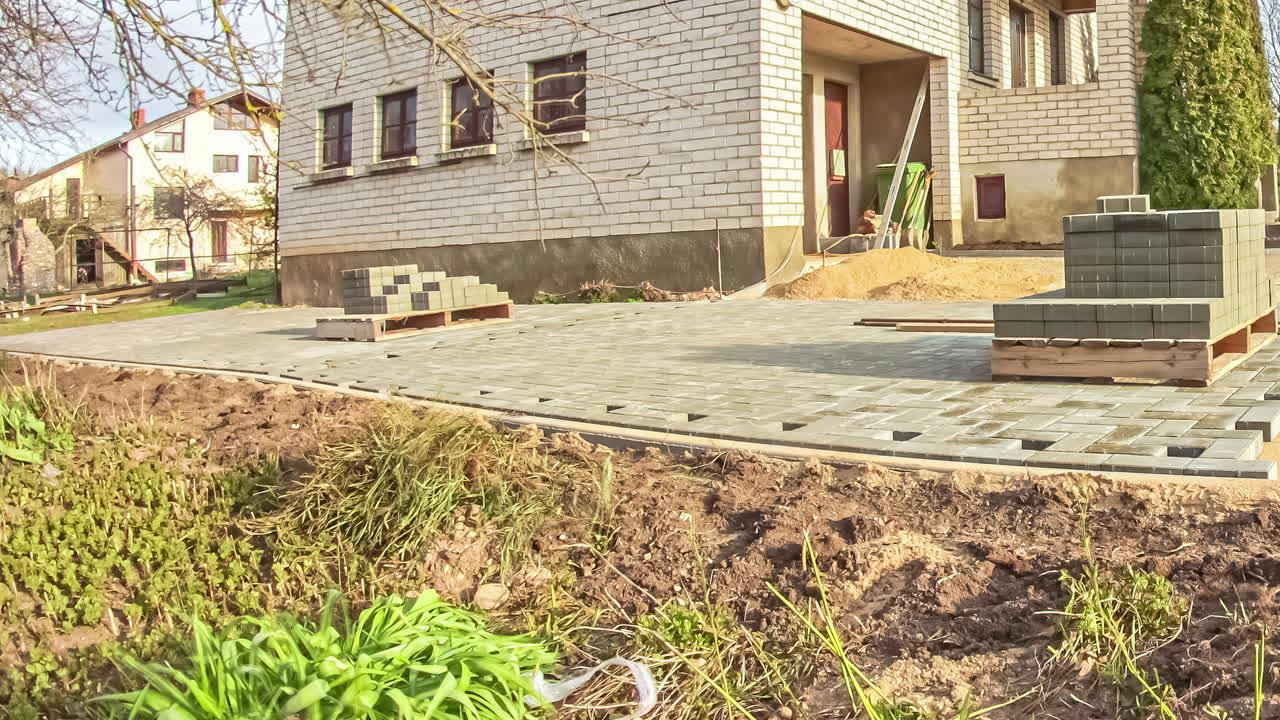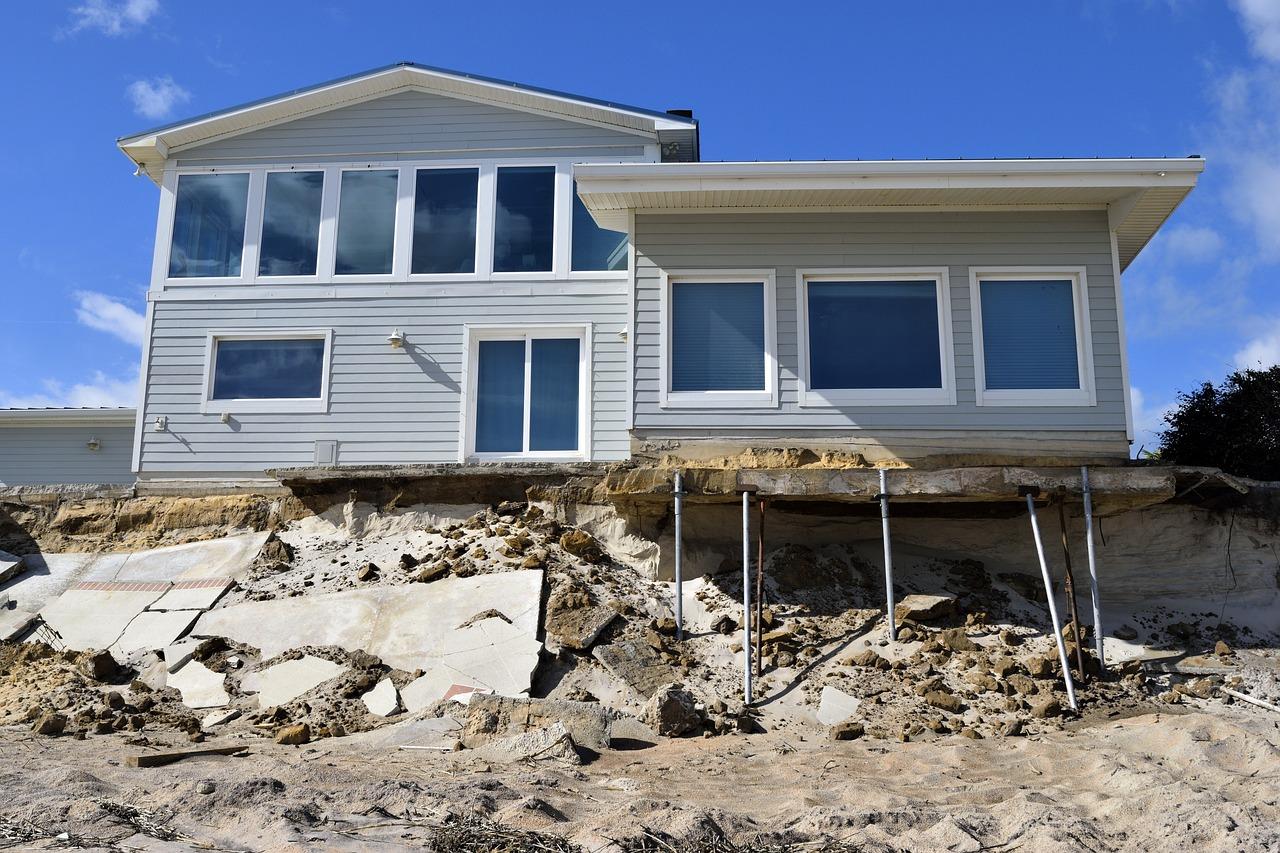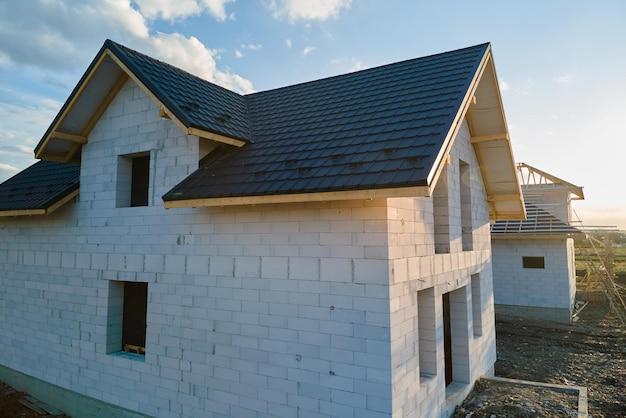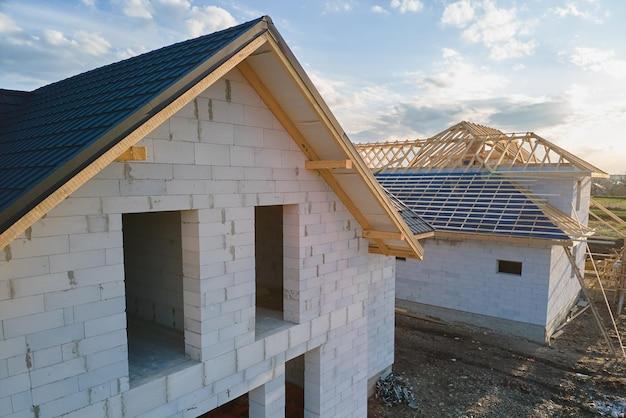Are you looking to elevate the appearance of your home’s exterior? One effective way to do so is by covering the concrete foundation with siding. By utilizing siding to conceal the foundation, you can achieve a polished and cohesive look for your house. In this blog post, we will explore the various aspects of siding over a concrete foundation, including how far the siding should overhang, whether or not it can be installed directly on the concrete, and the advantages of using vinyl siding. So let’s dive in and discover how you can give your home a stunning makeover while ensuring durability and functionality.
Siding Over Concrete Foundation: A Stylish Solution for Modern Homes
The Challenge of Concrete Foundations
When it comes to home construction, concrete foundations are a popular choice due to their durability and stability. However, they don’t always offer the most visually appealing aesthetics. If you’re looking to give your home a fresh new look, siding over a concrete foundation can be a game-changer.
What is Siding Anyway
Siding is a protective material that is placed on the exterior walls of a building to shield it from the elements. It not only acts as a protective barrier but also enhances the curb appeal of your home. From wood to vinyl to fiber cement, siding comes in a wide array of materials and styles, allowing you to customize the appearance of your residence.
The Benefits of Siding over Concrete Foundation
-
Enhanced Aesthetics: By siding over a concrete foundation, you can instantly transform the appearance of your home. Whether you prefer a classic and cozy look or a sleek and modern vibe, there’s a siding option that can cater to your taste.
-
Improved Insulation: Siding provides an added layer of insulation to your concrete foundation, helping to regulate the temperature inside your home. This can result in energy savings and increased comfort year-round.
-
Increased Durability: Siding acts as a shield, protecting your concrete foundation from external factors such as moisture, UV rays, and harsh weather conditions. By adding a layer of siding, you can significantly extend the lifespan of your foundation.
The Siding Options
-
Vinyl Siding: Vinyl is a popular choice due to its affordability, low maintenance requirements, and wide range of colors and textures. It’s also resistant to rotting, peeling, and cracking, making it a durable and long-lasting option.
-
Fiber Cement Siding: If you’re aiming for a high-end, refined look, fiber cement siding might be the perfect choice for you. It mimics the appearance of wood while offering exceptional durability and resistance to fire, insects, and rot.
-
Wood Siding: For those seeking a natural and rustic look, wood siding is an excellent option. It adds warmth and charm to your home but requires regular maintenance to prevent rotting or warping.
Finding the Right Professional
Siding over a concrete foundation is not a DIY project. To ensure a successful outcome, it’s crucial to hire a professional siding contractor who has experience with this specific type of installation. Research local contractors, read reviews, and request quotes to find the best match for your project.
Siding over a concrete foundation offers a host of benefits, including enhanced aesthetics, improved insulation, and increased durability. With a wide range of siding options available, you can find the perfect style to complement your home’s architecture. So, why settle for a dull concrete exterior when you can transform it into an eye-catching statement? Invest in siding over your concrete foundation and elevate the look of your home while enjoying the numerous advantages it brings.
Siding Options for a Solid Foundation
When it comes to choosing the right siding for your home, it’s essential to consider the foundation. The siding you select can have a significant impact on the overall appearance and durability of your house. In this subsection, we’ll delve into different siding options that work well for concrete foundations.
Vinyl Siding: A Budget-Friendly Choice
If you’re on a tight budget but still want durable and low-maintenance siding for your concrete foundation, vinyl siding is an excellent option. It’s one of the most popular choices due to its affordability and versatility. Vinyl siding comes in various colors, textures, and styles, allowing you to achieve the desired aesthetic for your home. Additionally, it’s resistant to rot, insects, and moisture, making it a practical choice for concrete foundations.
Fiber Cement Siding: Durability with a Modern Twist
For those looking for a siding material that combines the charm of wood with exceptional durability, fiber cement siding fits the bill. It’s made of a blend of cement, sand, and cellulose fibers, resulting in a robust and long-lasting product. Fiber cement siding is resistant to termites, rot, and fire, making it an ideal choice for homes built on concrete foundations. Moreover, it comes in various finishes to mimic the look of wood, brick, or stucco, providing homeowners with versatile design options.
Stucco Siding: A Classic and Timeless Appeal
Renowned for its timeless charm and durability, stucco siding is an excellent choice for concrete foundations. Made from a mixture of cement, sand, lime, and water, stucco creates a textured, elegant, and architectural look. It can withstand harsh weather conditions and has excellent fire-resistant properties. With stucco siding, you can achieve a classic and sophisticated aesthetic while ensuring your home is well-protected against the elements.
Stone Veneer Siding: Adding Natural Beauty
If you want to make a bold statement and add a touch of natural beauty to your home’s exterior, stone veneer siding is worth considering. Made from a thin layer of natural or manufactured stone, stone veneer siding offers the appearance of full-depth stone without the weight and cost. It adds texture, depth, and a rustic charm to your home’s facade while complementing the solid foundation provided by concrete. With its durability and timeless appeal, stone veneer siding is a great choice for homeowners who want to create a unique and eye-catching look.
Brick Siding: Classic and Graceful
For a classic and graceful look that stands the test of time, brick siding is an excellent choice for homes with concrete foundations. Brick is not only aesthetically pleasing but exceptionally durable and low maintenance. It provides excellent insulation properties, reducing energy costs in the long run. Brick siding is available in various colors and textures, allowing homeowners to create a customized and sophisticated look for their homes.
In conclusion, choosing the right siding for your home’s concrete foundation is crucial for both aesthetic appeal and durability. Consider the options mentioned above and select the one that aligns with your preferences, budget, and the overall character of your home. Whether you opt for vinyl, fiber cement, stucco, stone veneer, or brick siding, rest assured that your foundation will be well-protected while enhancing the beauty of your home.
House Foundation Covering Panels
Having an attractive and durable house foundation is essential for any homeowner. One popular method of enhancing the aesthetic appeal of a house foundation is by using covering panels. These panels not only add a touch of style but also provide protection and insulation to your home. In this subsection, we will delve into the world of house foundation covering panels and explore their benefits and installation process.
Choosing the Right Panels for Your Foundation
When it comes to selecting house foundation covering panels, you have a plethora of options to choose from. From traditional stone veneer to modern vinyl siding, the choices are endless. Consider factors such as cost, durability, and maintenance requirements to find the perfect fit for your foundation. Don’t be afraid to get creative and experiment with different materials to achieve the desired look.
Benefits of House Foundation Covering Panels
-
Enhanced Visual Appeal: House foundation covering panels instantly transform the appearance of your home. Whether you opt for a rustic brick finish or a sleek and modern design, these panels will give your foundation a much-needed facelift.
-
Protection from the Elements: Since the foundation is exposed to different weather conditions, covering panels act as a protective layer. They shield the foundation from moisture, UV rays, and other external elements that could cause damage over time.
-
Improved Insulation: Installing covering panels can significantly improve the insulation in your home. They act as an additional barrier against heat loss during winter and heat gain during summer, helping you maintain a comfortable indoor temperature all year round.
Installation Process
While the installation of house foundation covering panels may seem like a daunting task, it can be relatively straightforward with the right guidance. Follow these steps to ensure a successful installation:
-
Preparation: Clean the foundation surface thoroughly and ensure it is dry and free from any debris. Measure and cut the panels according to the dimensions of your foundation.
-
Applying Adhesive: Apply a layer of construction adhesive to the back of the panel and press it firmly against the foundation, starting from the bottom and working your way up. Use a level to ensure the panels are properly aligned.
-
Securing the Panels: Use screws or nails to secure the panels in place, making sure they are securely fastened. Repeat this process for each panel, ensuring a seamless and uniform appearance.
-
Finishing Touches: Once all the panels are in place, fill any gaps or joints with caulking for a polished look. You can also consider adding finishing touches such as trim or decorative elements to further enhance the overall aesthetic.
With these simple steps, you can easily transform your plain concrete foundation into a stunning architectural feature.
In conclusion, house foundation covering panels offer a practical and aesthetically pleasing solution for enhancing the appearance and protection of your foundation. By choosing the right panels and following a step-by-step installation process, you can give your home a stylish and durable foundation makeover. So go ahead, get creative, and give your house the foundation it deserves!
Should Siding Overlap Foundation
When it comes to siding your home, one question that often pops up is whether the siding should overlap the foundation. It’s an important consideration because getting this aspect right can make a big difference in the durability and overall appearance of your home. So, let’s dive into the topic of whether or not the siding should overlap the foundation.
Understanding the Purpose of Siding Overlapping the Foundation
Siding is not just about aesthetics; it serves a functional purpose as well. One of the main reasons for siding overlapping the foundation is to protect your home from moisture and other elements. By having the siding overlap the foundation, it creates a barrier that helps prevent water from seeping into your home’s structure, which can lead to issues like mold, rot, and even structural damage.
The Importance of Proper Installation
Proper installation is key when it comes to ensuring that your siding overlaps the foundation correctly. If the siding is not installed properly, it can leave gaps or spaces between the siding and the foundation, which can compromise the effectiveness of the overlap. This is why it’s crucial to hire a professional siding contractor who has the expertise to install the siding correctly and ensure a tight, secure fit.
Types of Siding Overlap
There are different methods of overlap used in siding installation. One common approach is called shiplap siding, where the siding boards are installed with a slight overlap, creating a watertight seal. Another method is known as tongue and groove siding, where the boards interlock with each other, providing a tight and secure fit. Both methods are effective in protecting your home’s foundation from moisture.
Benefits of Siding Overlapping the Foundation
Having the siding overlap the foundation brings several benefits. Firstly, as mentioned earlier, it helps keep water out, preventing potential damage to your home. Secondly, it adds an extra layer of insulation, enhancing the energy efficiency of your home. Finally, from an aesthetic standpoint, the overlap provides a clean and finished look to your home’s exterior.
In conclusion, yes, it is important for the siding to overlap the foundation. This ensures proper protection against moisture, adds insulation, and enhances the overall appearance of your home. Remember to hire a professional siding contractor to ensure that the installation is done correctly. With the right siding overlapping the foundation, you can enjoy a beautiful and well-protected home for years to come.
Vinyl Siding Directly on Concrete
Vinyl siding is a popular choice for homeowners looking to enhance the appearance and durability of their homes. It offers a range of benefits, from being weather-resistant to requiring minimal maintenance. But what about installing vinyl siding directly on concrete? Can it be done? The answer is yes, and in this section, we’ll explore the ins and outs of this option.
Understanding the Process
Installing vinyl siding directly on concrete may sound like a daunting task, but with the right know-how, it can be a relatively straightforward process. The first step is to ensure that the concrete is in good condition, free from cracks and other forms of damage. Any repairs should be made before proceeding with the siding installation.
Preparing the Surface
Before applying the vinyl siding, it’s essential to prepare the concrete surface properly. This involves thoroughly cleaning it to remove any dirt, dust, or debris. A power washer can come in handy here, as it helps remove stubborn stains and grime.
Applying the Vinyl Siding
Once the concrete surface is clean and dry, it’s time to apply the vinyl siding. Begin by attaching furring strips to the concrete using concrete screws or nails. These strips provide a solid base for the siding installation. Make sure they are placed at regular intervals to ensure proper support.
Benefits of Vinyl Siding on Concrete
Installing vinyl siding directly on concrete offers several advantages. First and foremost, it transforms the appearance of your home, giving it a fresh and modern look. Additionally, vinyl siding is highly durable and resistant to weather conditions, making it a long-lasting investment. Furthermore, it requires minimal maintenance, saving you time and effort in the long run.
Tips and Considerations
Before embarking on a vinyl siding installation directly on your concrete foundation, there are a few tips to keep in mind. Firstly, consult with a professional to ensure that this option is suitable for your specific foundation type. Secondly, choose high-quality vinyl siding that is designed for concrete applications. Lastly, consider your local climate and select siding with the appropriate insulation properties to maximize energy efficiency.
In Conclusion
Vinyl siding can be successfully installed directly on a concrete foundation, adding both visual appeal and protection to your home. By following the proper steps and considering the tips mentioned above, you can achieve a seamless and durable siding installation. So go ahead, explore the possibilities of vinyl siding on your concrete foundation!
How Far Should Siding Overhang Your Foundation
When it comes to the topic of siding over a concrete foundation, many homeowners find themselves asking, “How far should the siding overhang the foundation?” It’s an important question to consider because the answer can have a significant impact on both the functionality and aesthetics of your home’s exterior. So, let’s dive into this topic and find out the perfect overhang distance that will make your home stand out from the rest!
The Purpose of Siding Overhang
Before we discuss the recommended distance for siding overhang, let’s talk about the purpose behind it. The overhang serves as a protective barrier, shielding your foundation from rainwater, snow, and other elements. By extending the siding beyond the edge of the foundation, you create an extra layer of defense against potential water damage. Plus, it adds a visually appealing touch, giving your home a finished look.
Striking the Right Balance
So, what is the ideal overhang distance? While there’s no one-size-fits-all answer, a general rule of thumb is to aim for a 1 to 1.5-inch overhang. This distance strikes the perfect balance between functionality and aesthetics. With this overhang, you provide enough protection for your foundation while preventing excessive water runoff onto your landscaping.
Avoiding Common Pitfalls
While a 1 to 1.5-inch overhang is ideal, it’s crucial to avoid certain pitfalls to ensure the best results. First and foremost, beware of overextending the siding too much. A massive overhang may obstruct walkways, trap debris, and create a cozy nesting spot for pests under your siding. Nobody wants a raccoon hotel on their property!
On the flip side, a minimal overhang won’t provide adequate protection against water intrusion. It may even make your home look unfinished or oddly proportioned. Remember, finding that sweet spot is the key!
Customization and Climate Considerations
Keep in mind that the recommended overhang distance can vary based on your home’s design and climate. For instance, if you live in an area with heavy rainfall or significant humidity, you might want to consider extending the overhang slightly. On the other hand, if your region experiences high wind speeds, a shorter overhang could be wise to prevent wind-related issues.
Wrapping Up
When it comes to siding over a concrete foundation, finding the right overhang distance is crucial both functionally and aesthetically. Aim for a 1 to 1.5-inch overhang, but be mindful of your specific circumstances and climate. By striking the right balance, you’ll protect your foundation, make your home visually appealing, and avoid any unwanted wildlife guests. So go ahead, give your home that perfect touch with an overhang that’s just right!
Can Siding Be Installed Over a Concrete Foundation
If you have a concrete foundation and you’re considering giving the exterior of your home a facelift, the question of whether you can install siding over a concrete foundation might have crossed your mind. Well, you’re in luck, because the answer is a resounding yes! In this subsection, we’ll explore the possibility of installing siding over a concrete foundation and why it can be a great option for your home.
Why Choose Siding Over Concrete Foundation
Enhances Aesthetics and Curb Appeal
One of the main reasons why homeowners opt for siding over a concrete foundation is the instant boost it gives to the visual appeal of the house. Siding comes in various colors, styles, and textures, allowing you to choose the perfect look for your home. With options ranging from traditional to modern, you can effortlessly transform your house into a visual masterpiece.
Provides Additional Insulation
Another advantage of siding over a concrete foundation is the added insulation it provides. Siding acts as a barrier between the interior of your home and the elements outside, helping to regulate the temperature and reduce energy consumption. This can lead to significant savings on your heating and cooling bills, making siding a sound investment for the long term.
Protects Against Moisture and Damage
Concrete foundations can be prone to cracking or deteriorating over time. By installing siding over your concrete foundation, you create an extra layer of protection against moisture and potential damage. Siding is designed to withstand the elements, ensuring that your home remains safe and secure.
How Does the Installation Process Work
Installing siding over a concrete foundation involves several steps to ensure a proper and durable installation. First, the concrete surface must be thoroughly cleaned and prepared. This may involve power washing to remove dirt, grime, and any loose particles. Once the surface is clean and dry, an adhesive or mechanical fasteners are used to secure a layer of furring strips directly onto the concrete. These furring strips create an air gap between the concrete and the siding, allowing for proper ventilation and preventing moisture buildup.
With the furring strips in place, the siding can be installed using the manufacturer’s recommended method. This typically involves attaching the siding panels to the furring strips, ensuring a secure and visually appealing result. It’s important to follow the manufacturer’s instructions and guidelines during the installation process to ensure a successful outcome.
By now, you know that siding can indeed be installed over a concrete foundation. Not only does it enhance the aesthetics and curb appeal of your home, but it also provides additional insulation and protection against moisture and damage. If you’re looking to give your home a fresh new look, installing siding over your concrete foundation might just be the perfect solution. So go ahead, explore the options, and get ready to transform your home into a true showstopper!



